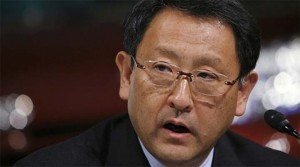Not long ago seen as the auto industry’s invincible 800-pound gorilla, the problems keep piling up for Toyota, and that’s worrying the folks who have to put a rating on the maker’s debt – Moody’s downgrading Toyota and warning it could cut the debt rating again in the months ahead.
The Japanese giant still commands the investment-grade rating its Detroit rivals can only dream of, but the latest move by the powerful ratings service underscores growing concerns about Toyota’s ability to cope with problems ranging from quality to new competitors, as well as the setbacks it has suffered in the wake of the March 11 disaster in Japan that will likely reduce its production this year by close to 500,000 vehicles.
It will “take some time,” a statement from Moody’s Investor Services said, for Toyota to “recover its previous strong profitability.”
As a result, the agency lowered from Aa2 to Aa3 – which is still its fourth-highest credit ranking. But it follows a downgrade earlier this year by Standard and Poors, and Moody’s warned that yet another downgrade could come soon because Toyota’s ratings “incorporate one notch of support from the country’s banks and government, which are themselves under review for possible downgrade.”
Toyota’s downward momentum comes at an awkward time. The long-struggling Detroit makers are beginning to show signs of revival, Ford Chief Financial Officer Lewis Booth recently telling TheDetroitBureau.com the company will continue slashing its debt with the goal of regaining an investment-grade rating within the next year.
The improved vitality of Detroit’s Big Three is just part of the competitive pressures on Toyota. The maker is now challenged by two Korean upstarts, Hyundai and Kia, which have clearly targeted the Japanese giant.
Closer to home, Carlos Ghosn, CEO of Nissan, this week announced his new Power 88 plan which aims for a dramatic increase in sales, market share and profits over the next six years. Japan’s second-largest maker has come through the aftermath of the March earthquake and tsunami in much better shape than its big rival, many analysts believe.
That underscores the potential problems facing Toyota because of its continued heavy dependence on its home market production network. And Japan’s vulnerability to earthquakes is only one of the issues. The maker has also been snagged by the strong rise of the yen versus the dollar, which means a sharp decline in earnings from the U.S., normally Toyota’s largest profit center.
The maker has been pressing to expand its presence in emerging markets, but it lags well behind rivals General Motors and Volkswagen in what is now the biggest market in the world, China. That gap – as well as the loss of production due to the March disaster – is expected to propel GM to the number one spot in global sales this year. Meanwhile, VW has set an active goal of becoming number one before the end of the decade.
Just days before the March quake, Toyota CEO Akio Toyoda outlined an aggressive growth plan of his own that would boost worldwide production to around 10 million vehicles annually and drive up profit margins, as well. The speech drew a mixed reaction, however, many observers cautioning it was short of specifics.
For the moment, the details don’t look good. Since 2008, Toyota’s earnings have tumbled by more than 75% — though it was still one of the most profitable makers for the fiscal year that ended March 31, with earnings of 408 billion yen, or $4.8 billion. But those numbers showed little impact from the earthquake which – along with lopsided exchange rates – will likely drive the figure down to 280 billion yen, or $3.4 billion, for the current fiscal year.
Toyota’s appearance of vulnerability comes at a time when the maker had been hoping to shed the after-effects of the quality and safety problems that led it to order the recall of more than 10 million vehicles in 2010 – while paying a series of record fines to the U.S. government for failing to respond to safety problems in a timely manner.
Toyota got a reminder of that issue this week when it announced the recall of more than 80,000 hybrid SUVs sold in the U.S.
A recent study, put together by a panel that included former U.S. Sec. of Transportation Rodney Slater, warned that Toyota needs to decentralize its management structure, giving more power to its various regional operations, including its vast and expanding American subsidiary.
The maker’s U.S. sales are expected to post another decline for June due to quake-related shortages. On the positive side, Toyota says it is recovering faster than it expected from the disaster, and should have production back to normal in the next several months.

